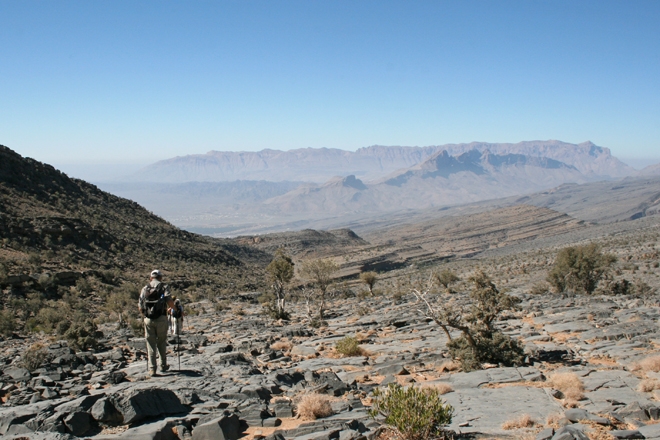Trekking the Omani Hajar
Many people think that the Arabian Peninsula is just desert and more desert but, while there is admittedly a lot of desert, there are also dramatic mountains, wadis and coastlines. Oman, despite being 75% desert, also has
 Trekking in the Hajar Mountains. Image by S Piper
Trekking in the Hajar Mountains. Image by S Piper
Many people think that the Arabian Peninsula is just desert and more desert but, while there is admittedly a lot of desert, there are also dramatic mountains, wadis and coastlines.
Oman, despite being 75% desert, also has 1,700 km of striking coastline and mountains that reach just shy of 3,000m. Jebel Shams, at a peak of 2,996m, is the highest point. Here temperatures are appreciably cooler than the coastal plains and, fleetingly, they get snow every year. Jebel Shams (Sun Mountain) together with the nearby Jebel Akhdar (Green Mountain) make up the Western Hajar range.
The trekking in Oman is not for the faint-hearted; the terrain is rocky and in places unforgiving. It lacks the smooth surfaces of nicely weathered rock that you might find elsewhere and the ascents and descents are steep. This makes it all the more remarkable that the Western Hajar is well populated with villages and towns that were established centuries and sometimes longer ago. The main motivation for living in such rough and steep terrain is the temperatures. Not only is it more tolerable than the 45 degree centigrade summer temperatures of Muscat but it also means that the season for growing crops is longer.
Amongst the villages clinging to the precipitous cliffs (where legend has it that children are traditionally tied to their beds at night to make sure they don’t fall), are serene plantations of date trees interspersed with mango, banana and papaya. Grapes are grown and were traditionally used to produce a local wine although I am told this no longer happens, apparently. The wild honey from amongst the wadis is some of the most expensive in the world. Roses are harvested from the tiered fields around May and distilled into rose water.
Further to the East is the aptly name Eastern Hajar mountain range. This extends to the East of Muscat towards Sur and the edge of Arabia. While the mountains here are not so high (around 2,200m) they are more remote and considerably less populated. From the coastal villages of Fins and Tiwi, one can quickly ascend on a very steep gravel track 1,200m to a view point looking back down to the sea with only a kettle of Egyptian vultures for company. The ascent from here is more gradual but no less dramatic as you cross the Selmah Plateau, gradually climbing to around 2,000m. You will start to notice odd shaped domes that initially appear to be out-of-place rocks but, as you get closer, are clearly man-made structures. These are known as the Beehive Tombs for their looks of the Bat Tombs after one of the locations in the West of Oman that is recognised by UNESCO. There are plenty of theories and too little research into their history however, my two favourite and contrasting theories are: according to one of our guides, there was an evil gin (spirit) called Selmah who terrorised the locals to such an extent that, when they finally captured her, they cut her in to 90 pieces and built a tomb for each piece to be buried under to ensure that she could never come back to life. A more western theory is that they are burial tombs for prominent elders of the Azd tribe and date from perhaps 3,000 years ago. The challenge here is that no evidence has been found to suggest that there were people living on the plateau at that time and so the conclusion is that they are the elders from the villages on the coast that were carried all the way up to the plateau. I know which of these theories I prefer…
The Mountains & Deserts of Oman trekking holiday with Mountain Kingdoms visits the Al Hajar and Jebel Shams ranges. The trek takes you through spectacular scenery of mountains, gorges and canyons whilst staying in remote camps that give you a real taste of the wild.